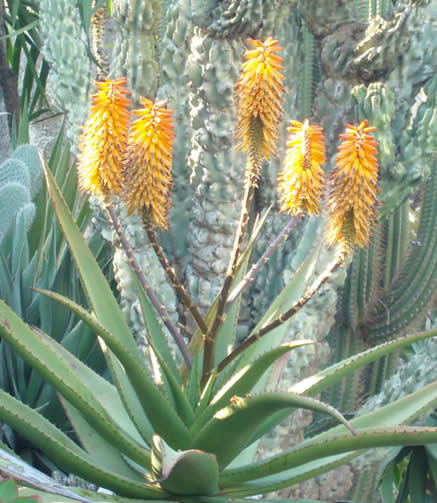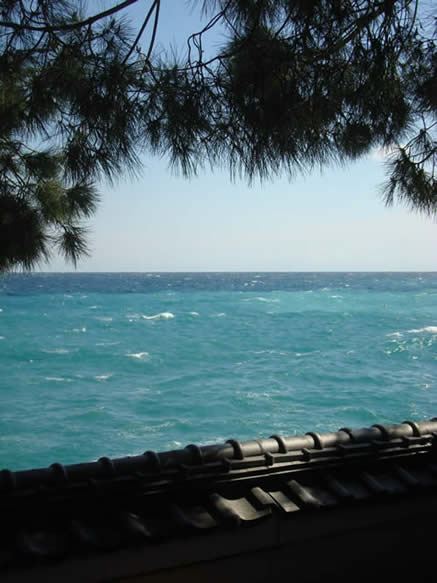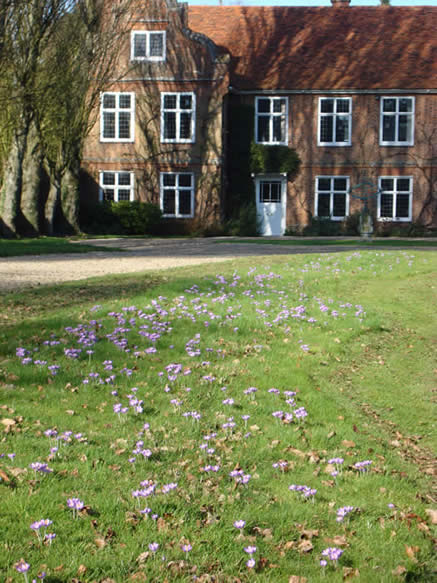Tree L.C.
9 April 2009
A hands-on day at Kew, with members of the International Dendrology Society, to learn from the curator of the country’s most important tree collection. You might think that growing trees was a skill long since done and dusted. Not on Tony Kirkham’s watch. From the pot to the hole, the compost to the mulch, the label to the stake, the guard to the watering regime, the planting to the pruning, every practice is reviewed and questioned. The result: many happy young trees, and a day of engrossing interest.
Micorrhyza come high on Tony’s agenda. He adds them, in the form of a product called Transplant 1-Step, to every planting hole. He even waters them on to the roots of established trees that need encouragement. His thinking is that intimate and instant contact between roots and soil is paramount, and
Alliummm
7 April 2009
The chives are up, and my spirits with them. Grass, I know, is just as handsome, and almost every plant at this moment more interesting, but chives represent a tasty turning-point: fresh herbs for fresh spring food. Scattering the fine cuttings on a salad, or on the yellow of eggs, gives me quite disproportionate pleasure.
To the French they constitute, with parsley, tarragon and chervil, ‘fines herbes’: an omelette made more vivid, green specks among the marbled yellow and brown. Chives alone make Sauce à
Rockery
25 March 2009
Menton, Grasse, Cap Ferrat……. plenty of places along the Côte d’Azur are famous as horticultural destinations. You don’t hear much about the gardens of Monte Carlo, though. Or about Monte Carlo, these days, at all. The romantic destination of gangsters and grannies seems to have lost its identity in the more business-like Monaco.
Tiny as it is, squeezed between cliffs and the Mediterranean, the principality seems too thickly planted with tower blocks to offer gardeners a chance. It is, on the other hand, one of the richest towns on earth, prinked up and garnished with flowers in all seasons, its streets swept day and night, its trees pruned with extreme daring (‘élagage acrobatique’ boasts one firm of arborists); no trouble too much; no shortage of labour. And its climate, sun-baked and sheltered from all but east winds, with spring in early March, positively provokes planting. Such full-dress public outbreaks as the gardens of Casino Square push gardenesque style to the limit, with the emphasis on palm trees.
There are two gardens, though, that are worth the detour and speak in garden languages about as distinct as they can be. The Jardin Exotique, clinging to the cliff tops as you come into town from Nice, is the prickliest display of xerophytes this side of Arizona, and in balmy, tranquil, seductive and oriental contrast, the other end of town on the way to Menton, is the Jardin Japonais.
The idea of cultivating cactus, and everything else rebarbative, on ledges and in niches in vertical bare rock, came to the same scientific prince as the oceanographic museum which is Monaco’s pride. His local gardener contrived a network of paths, steps and terraces that scale several hundred feet of rock fantastically eroded by the wind. Where the rock was missing, or not fantastic enough, he made artificial outcrops and overhangs.
For barriers and handrails to the knee-trembling paths he used concrete loggery. (I search in vain for a name for the faux-branch- and-twig-in-cement idiom). A more arid, exposed and uncomfortable site it is hard to imagine. And yet it is beautiful. It is wrapped, draped and studded with formidable plants in the peak of health; vegetable dinosaurs, scaly, armour-plated and above all prickly. They shoot, slither, squirm and threaten, light up with orange daisies or scarlet truncheons or suddenly rocket up twenty foot white plumes. It is brutalist botany; the principles of plant life spelt out in angry uncompromising terms. You couldn’t fail to be fascinated.
The Japanese Garden is more recent; part of the décor of a pampered and profitable beachfront, secluded behind tile-topped walls, demure, formal, teetering on the edge of tweeness and yet so disciplined, so precisely mannered that you surrender.
It is big enough to live its own life, even
Purple path
4 March 2009
Snowdrops, of course. They signal the start of everything, in their chilly way. The warm feelings of spring, though, start with the first crocuses, which, in this garden, are C. tommasinianus.
A lugubrious friend told us, many years ago, that they were a pernicious weed. I saw them carpeting an orchard with their piercing purple and saw, absurdly, danger. The summer ground cover in this orchard was ground elder, so perhaps it was just the association of ideas. I didn’t take them seriously, in fact, until I saw a mighty river of them at Benington Lordship, a picture I can summon up in an instant: a great path of purples, darker and paler and intricately flecked with orange and gold.
I resolved to copy it, and four years ago planted 2000 in a band twelve feet wide along one side of the front drive. Now I’m reaping my reward.
Crocuses make you long for the sun to come out. They will stand patiently for days like little rockets on pale stems waiting for the clouds to pass. The moment the grass glows with sunlight their petals tremble, part and spread, eager for the bees. In no time, from nowhere, a working party arrives and forages every flower. The show is over then; the flowers are spent, sheaves of leaves take their place, not to be mowed (I have made this mistake) until they become invisible in the springtime grass. Next year you will have double the concentration, the beginnings of a proper rug, and cheeky adventurers for many yards around.
Catching the sunny day is of course the problem part. It will be your day in London, or taking the car for its service. It never occurred to me until last winter to plant a big shallow bowl of them and bring them into the kitchen when their pale points appear. Trustingly they took the (halogen) ceiling lights for sunshine, grew and opened, then shut again, repeating their performance, the kitchen being bee-free, over the space of two weeks. A second wave of smaller
|
micorrhyza ensure that contact. He favours square planting pits, scarcely deeper than the root balls they are to accommodate but four times as wide. Round holes, he believes, only encourage roots to circle. Does a root know it has hit a straight wall rather than a curved one? Apparently it does. And Kirkham doesn’t add organic matter; just backfills with the mineral soil. But then Kew is on sand. He doesn’t add fertilizer when he plants a tree, either. It kills micorrhyza. Bone meal perhaps in the second year, scattered on the surface. By then, he reckons, the roots will have filled the pit and be foraging in the surrounding undug ground.
There was much more, from ‘Airpots’ (and planting out as young as possible) to a system for decompacting the soil under mature trees by forcing in compressed air. (Again, I felt that what works in Kew’s sand would get stuck in Essex clay.) The entire root area is then treated with glyphosate to kill the grass and mulched with wood chippings, preferably of the same species of tree.
To answer the problem of watering young trees he showed us a new American device I shall certainly look for. It is simply a bag with a leaky bottom that holds 20 gallons of water. You fasten it round the trunk and it leaks very slowly where the water does most good. It is called a Tree-gator, but never mind.
la ciboulette, a delicate dressing for fish or a salad, whether in the richer form of a speckled mayonnaise or a pale and pourable cream. One of the chef’s star turns at the Garrick Club is a little smoked haddock soufflé: you dent the crisp brown crust with your spoon and pour in the cool white and green sauce, mingling fish and salt and smoke and hot and cold and the hint of onion.
Spain has a hairier-chested equivalent to the delicate French omelette: Huevos con ajos is scrambled eggs green-striped with fresh garlic shoots. These are dishes that spell spring, to follow with fresh spears of broccoli, and very soon asparagus. Here, I’m afraid, I take issue with the Spanish. They not only blanch the beautiful green shoots into gross white digits; they seem to think that canning them is a necessary step on the way to the table.


under tower blocks, and even beside the sea.
The day I first saw it the sea was furious. The Levante was tormenting it, whipping white horses out of sunlit sapphire rollers, flashing as they charged, bursting in silver explosions on the breakwaters and rocks. All right: that was an aberration. Water means tranquillity in the Kyoto code. To watch the racing waves, though, beyond the protecting wall and between the sculpted pines, only intensified the sense of courtly privilege, where brilliant carp navigate tiny stone islands and raked gravel represents an ocean. Camellias are absurdly luscious; maples fine-filigreed as lace.
Both these gardens, it occurred to me, however different in purpose and intention, are essays in stone. Rocks, the feelings they evoke and the conditions they impose, are at the heart of them both.

flowers followed the first so that we had an enchanted forest to admire at breakfast, lunch and dinner.
The garden crop, meanwhile, only a few days later than those indoors, were suddenly and brutally depleted. One morning I saw that almost all the paler ones, more silvery lilac than purple, had been mown down. Or, on closer inspection, cropped off. Rabbits only nibble; this was grazing on a bigger scale. Muntjac were the felons.
Days later the Radio 4 Food programme considered the problem of the deer population; the highest, apparently since the last Ice Age. ‘Are they safe to eat?’ asked someone – of the food our forebears (or the fortunate ones) ate for centuries before they had cattle. No one, to my frustration, mentioned muntjac, or how their meat is sweetest of any deer.
Is there anything, short of warfare, that we can do to protect our crocuses? I am trying a new product called Grazers, a systemic spray that, once the plant has taken it up, reputedly gives it qualities that deer, rabbits, and even pigeons find repulsive. Do systemics work on bulbs? Is there time in their short growing season? I shall report my findings.
|